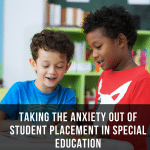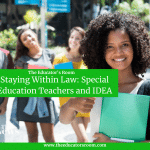By Tamara V. Russell, NBCT
Each year during the months of January and February, elementary school classrooms across the country whitewash the story of Dr. Martin Luther King and the Civil Rights Movement. Because students are so young, many times teachers will limit the scope of the movement to the idea that Dr. King was a man with a dream. The legacy of Dr. King is not that we live in a post-racial society because our students have friends of different races. Dr. King’s legacy is in protest. It is in the idea that any ordinary American could work collectively to disrupt the structures of power that contribute to racism, poverty, and hyper-militarization.
So, elementary school teacher—I challenge you to reframe your instruction of Dr. King this year.
Let’s examine these quotes from Dr. King.
- “Every man of humane convictions must decide on the protest that best suits his convictions, but we must all protest.” -Dr. King “Beyond Vietnam: A Time to Break Silence”. 1967
- “Again we have deluded ourselves into believing the myth that Capitalism grew and prospered out of the Protestant ethic of hard work and sacrifice. The fact is that capitalism was built on the exploitation and suffering of black slaves and continues to thrive on the exploitation of the poor – both black and white, both here and abroad.” -Dr. King “The Three Evils of Society” 1967
This ‘version’ of King is not what is resonant in the majority of elementary school classrooms.
But how could we teach King authentically, and yet in a way that students can understand the complexities of the time?
I submit to you four ways that I’ve adjusted my own instruction.
Begin with organizing
This has been the cornerstone of how I have taught the Civil Rights movement. The Civil Rights Movement of the 1960s would have never been possible without organizing. As educators, let’s disrupt the narrative that individualism is the key to greater access and freedom for people who have been marginalized. It most assuredly is not. Starting from organizing is a great springboard to other conversations related to justice work in a historical sense. When thinking of the Civil Rights Movement of the 1960s, consider introducing your students to the books Pies from Nowhere: How Georgia Gilmore Sustained the Montgomery Bus Boycott by Dee Romito, Freedom on the Menu, and The Voice of Freedom: Fannie Lou Hamer by Carole Boston Weatherford. Looking closely at how people have used protest and organizing as a strategy to get the word out about unjust practice is historical. It’s the basis for much of the protest work that we see being done in the United States today.
Avoid white-washed, non-disruptive narratives
It’s not enough for elementary-aged learners to leave our schools thinking that Martin had a dream, Rosa was tired and Ruby had courage. Even kinder kids can discuss the concepts of power, fairness, and justice within their scope. Although they may not understand the complexities of how segregation came to be…and at 5 may not developmentally be able to understand. They do understand power and authority. Most kindergarten standards require that teachers teach symbols, community helpers, and school-based leaders. That’s teaching kids ‘who has power’. If we can do that without batting an eye? We can talk about the importance of using our power the right way and creating space for others in a way that shows we care.
Read primary sources & compare them to modern organizing
I’ve done different things related to this with different classes. One year, I read aloud the ‘Letter from the Birmingham Jail’ and compared it to news articles I’d found on Colin Kaepernick and had the students write an opinion piece on whether or not professional athletes should use their platforms to talk about social justice. The responses were varied and the discussions were rich! A great book to get you thinking on how to integrate this into your own classroom is Civil Rights Then & Now by Christina Brooke Danielle. Even just using a few sections of the text for discussion or to support your framing could be powerful.
Define protest as a fundamental, constitutional right
This is a final thought.
We’ve seen the concept of protest demonized by certain groups in the last few years. This country was founded on the idea of public protest and property destruction as a means to communicate the deep upset at persistent oppressive policy. Protest is a fundamentally American concept and it’s codified in the first amendment. As educators, we lay the groundwork for critical thought. Elementary-aged students can learn about organizing and even protest as a way to have their collective needs met. They can learn to stand in solidarity with causes that are resonant to them and to their communities. We offer such a gift when we teach them how to not only advocate for themselves but work collectively to advocate for their communities.





